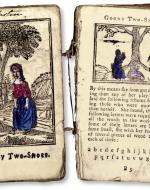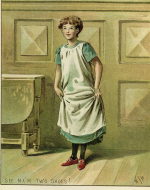Created by Brooke Bernstein on Tue, 10/15/2024 - 11:15
Description:
Today "goody two shoes" is a derogatory reference to a sicky-sweet person who is insufferably virtuous, but few people know where the phrase originated or that it was not always a disparaging label. "Goody Two Shoes" refers to the allegorically named Margery Meanwell, the lead character in the didactic work The History of Little Goody Two Shoes (1765), a children's book believed to be written by Irish author and playwright Oliver Goldsmith of She Stoops to Conquer (1773) fame. The term "Goody" is an abbreviation of "Goodwife," a designation for "Missis" in the 18th century that Margery earns by becoming financially independent. The label "Two Shoes" comes from the plot: after Margery loses her mother and father, Margery and her brother are reduced to poverty with Margery wearing only one shoe; a wealthy patron adopts Margery's brother, but he buys Margery a new pair of shoes, which launch Margery on her mission for self-improvement and success. Despite its strong moral message, book historian V.M. Braganza calls the book "revolutionary" in an essay entitled "The Revolutionary Influence of the First Children's Novel," published in the Sept/Oct 2023 issue of Smithsonian Magazine. This "largely forgotten Cinderella story broke social and literary barriers while delighting readers," adds Braganza; "Over the course of the novel, Margery teaches herself to read, foils a major robbery, founds a school, earns her own living, stands up for animal rights and overcomes accusations of witchcraft. She was everything that 18th- and 19th-century British society thought women shouldn’t be: poor, well-educated, self-made and unmarried (at least until the last few pages)" (https://www.smithsonianmag.com/arts-culture/revolutionary-influence-firs...). It was republished widely in the 18th and 19th centuries, and authors including Regency novelist Jane Austen and Victorian poet laureate Robert Southey considered Two Shoes a beloved book. While today "Goody Two Shoes" is no longer an icon for female independence, book historians recognize the book's importance not for its dated morality but for promoting women's independence; many credit Little Goody Two Shoes for launching a genre that features a child as a protagonist, a genre that includes TThe Wizard of Oz, The Chronicles of Narnia, and Harry Potter.
Book Cover, Little Goody Two Shoes (1765), 1888 edition. The book credited to Oliver Goldsmith follows a recently orphaned young girl, Margery Meanwell, who only has one shoe. Upon receiving a second shoe, Margery’s spirits life, and she quickly moves past her grief and devastation to gain education and a livelihood. Over the course of the book, Margery takes on various selfless tasks. She teaches children to spell, stops criminals, and becomes known for her kindness. Margery is so good that “foolish people” accuse her of witchcraft, and she is put on trial, but proven innocent. For all her selfless acts, Margery--an independent and intelligent woman--is rewarded with a marriage, and the entire town celebrates. Because of her good deeds, Margery’s “life was a great blessing, and her death the greatest calamity” (Goldsmith 18). This book cover features Margery surrounded by animals (birds, a dog, and a sheep), a nod to her involvement in animal rights long before Sewell published Black Beauty (1877). Margery wears a mop cap, but other illustrations show her holding what she ingeniously calls a "considering cap"--anticipating what today we call a "thinking cap." The cover also features the "ABC"s to signal Margery's hands-on learning style and her signature shoes.
Sir Joshua Reynolds, Portrait of Oliver Goldsmith, ca. 1769-70, National Portrait Gallery, Wikipedia. Anglo-Irish writer Oliver Goldsmith (1728-74) is credited as being the author of Little Goody Two Shoes. Goldsmith is best known for The Vicar of Wakefield (1766), a comedic novel about a generous vicar who gives his money away to his parishioners, and She Stoops to Conquer (1773), a Restoration comedy about a man tricked into believing the house of his potential intended is an inn. In this colored portrait, Goldsmith holds a book, a symbol of intellect in 18th-century portraiture. Goldsmith's identity as author of the iconic children's tale remains unconfirmed even today.
Jane Austen’s personal copy of The History of Little Goody Two Shoes (1765), published in "The Revolutionary Influence of the First Children's Novel," Sept/Oct 2023 issue of Smithsonian Magazine. Little Goody Two Shoes had a massive cultural impact. It became one of the most popular books of the eighteenth century, and its legacy has been enduring. Jane Austen kept her childhood copy until her death when she passed it down.In this two-page spread, Jane Austen's name appear on the first page above an illustration of Margery out in a field, notably wearing two shoes. The opposite page shows Margery sharing her knowledge with those who know less than her. An incredibly generous and selfless young girl, she teaches children how to spell. As a teacher, Margery establishes moral values of hard work, perseverance, and selflessness as well as woman's independence. How fitting that Austen, a woman novelist whose books remain classics, found inspiration in Margery Meanwell's story.
W.J. Hodgson, "See Ma'm Two Shoes!" for Little Goody Two Shoes, 1891 edition. Hodgson features the title character showing off her famous shoes. The girl's expression shows her pride in her new footwear. Margery even lifts her skirt to show off teh bright red shoes, anticipating Dorothy's ruby red slippers in The Wizard of Oz (1900). Long before Dorothy sets off for Oz, Margery shows her resilience and independence as a heroine, launching a genre of child-focused literature that continues today in mroe entertaining books included in this exhibit, notably The Wizard of Oz and C.S. Lewis's The Lion, the Witch, and the Wardrobe.
Case completed by Dr. Catherine J. Golden





